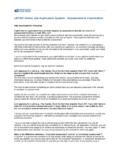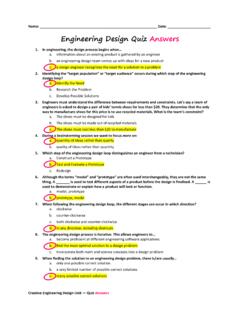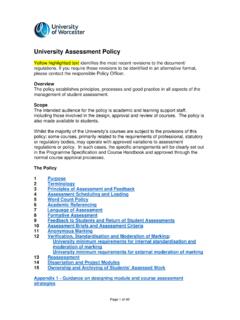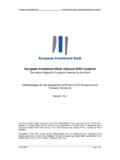Transcription of Ballistic Resistant Protective Materials (Revision)
1 Department of Justice National Institute of Justice National Institute Technology assessment of Justice Program Ballistic Resistant Protective Materials NIJ Standard ABOUT THE TECHNOLOGY assessment PROGRAM. The Technology assessment Program is sponsored by the Office of Development, Testing, and Dissemination of the National Institute of Justice (NIJ), Department of Justice. The program responds to the mandate of the Justice System Improvement Act of 1979, which created NIJ and directed it to encourage research and development to improve the criminal justice system and to disseminate the results to Federal, State, and local agencies. The Technology assessment Program is an applied research effort that determines the technological needs of justice system agencies, sets minimum performance standards for specific devices, tests commercially available equipment against those standards, and disseminates the standards and the test results to criminal justice agencies nationwide and internationally.
2 The program operates through: The Technology assessment Program Advisory Council (TAPAC) consisting of nationally recognized criminal justice practitioners from Federal, State, and local agencies, which assesses technological needs and sets priorities for research programs and items to be evaluated and tested. The Law Enforcement Standards Laboratory (LESL) at the National Bureau of Standards, which develops voluntary national performance standards for compliance testing to ensure that individual items of equipment are suitable for use by criminal justice agencies. The standards are based upon laboratory testing and evaluation of representative samples of each item of equipment to determine the key attributes, develop test methods, and establish minimum performance requirements for each essential attribute.
3 In addition to the highly technical standards, LESL also produces user guides that explain in nontechnical terms the capabilities of available equipment. The Technology assessment Program Information Center (TAPIC) operated by a grantee, which supervises a national compliance testing program conducted by independent agencies. The standards developed by LESL serve as performance benchmarks against which commercial equipment is measured. The facilities, personnel, and testing capabilities of the independent laboratories are evaluated by LESL. prior to testing each item of equipment, and LESL helps the Information Center staff review and analyze data. Test results are published in Consumer Product Reports designed to help justice system procurement officials make informed purchasing decisions.
4 Publications issued by the National Institute of Justice, including those of the Technology assessment Program, are available from the National Criminal Justice Reference Service (NCJRS), which serves as a central information and reference source for the Nation's criminal justice community. For further information, or to register with NCJRS, write to the National Institute of Justice, National Criminal Justice Reference Service, Washington, DC 20531. James K. Stewart, Director National Institute of Justice Department of Justice National Institute of Justice Technology assessment Program Ballistic Resistant Protective Materials NIJ Standard September 1985. DEPARTMENT OF JUSTICE. National Institute Of Justice James K. Stewart, Director ACKNOWLEDGMENTS. This standard was formulated by the Law Enforcement Standards Laboratory (LESL) of the National Bureau of Standards under the direction of Daniel E.
5 Frank, Manager, Protective Equipment Program and Lawrence K. Eliason, Chief of LESL. The technical research was performed by Nicholas J. Calvano of the Automated Production Technology Division. The standard has been reviewed and approved by the Technology assessment Program Advisory Council and adopted by the International Association of Chiefs of Police (IACP) as an IACP standard. FOREWORD. This document, NIJ , Ballistic Resistant Protective Materials , is an equipment Standard developed by the Law Enforcement Standards Laboratory of the National Bureau of Standards. It is produced as part of the Technology assessment Program of the National Institute of Justice (NIJ). A. brief description of the program appears on the inside front cover. This standard is a technical document that specifies performance and other requirements equipment should meet to satisfy the needs of criminal justice agencies for high-quality service.
6 Purchasers can use the test methods described in this standard to determine whether a particular piece of equipment meets the essential requirements, or they may have the tests conducted on their behalf by a qualified testing laboratory. Procurement officials may also refer to this standard in their purchasing documents and require that equipment offered for purchase meet the requirements. Compliance with the requirements of the standard may be attested to by an independent laboratory or guaranteed by the vendor. Because this NIJ standard is designed as a procurement aid, it is necessarily highly technical. For those who seek general guidance concerning the selection and application of law enforcement equipment, user guides have also been published. The guides explain in nontechnical language how to select equipment capable of performance required by an agency.
7 NIJ standards are subjected to continuing review. Technical comments and recommended revisions are welcome. Please send suggestions to the Program Manager for Standards, National Institute of Justice, Department of Justice, Washington DC 20531. Before citing this or any other NIJ standard in a contract document, users should verify that the most recent edition of the standard is used. Write to: Chief, Law Enforcement Standards Laboratory, National Bureau of Standards, Gaithersburg, MD 20899. Lester D. Shubin Program Manager for Standards National Institute of Justice iii NIJ STANDARD. FOR. Ballistic Resistant . Protective Materials . CONTENTS. Page Foreword iii 1. Purpose 1. 2. Scope and Classification 1. 3. Definitions 2. 4. Requirements 4. Acceptance Criteria 4.
8 Workmanship 4. Labeling 4. Ballistic Resistance 4. 5. Test Methods 6. Sampling 6. Test Equipment 6. Ballistic Resistance Test 7. Appendix A References 9. v COMMONLY USED SYMBOLS AND ABBREVIATIONS. A ampere H henry nm nanometer ac alternating current h hour No. number AM amplitude modulation hf high frequency outside diameter cd candela Hz hertz (c/s) W ohm cm centimeter inside diameter p. page CP chemically pure in inch Pa pascal c/s cycle per second ir infrared pe probable error d day J joule pp. pages dB decibel L lambert ppm part per million dc direct current L liter qt quart C degree Celsius lb pound rad radian F degree Fahrenheit lbf pound-force rf radio frequency diam diameter lbf in pound-force inch rh relative humidity emf electromotive force lm lumen s second eq equation ln logarithm (natural) SD standard deviation F farad log logarithm (common) sec.
9 Section fc footcandle M molar SWR standing wave radio fig. figure m meter uhf ultrahigh frequency FM frequency modulation min minute uv ultraviolet ft foot mm millimeter V volt ft/s foot per second mph mile per hour vhf very high frequency g acceleration m/s meter per second W watt g gram N newton l wavelength gr grain N m newton meter wt weight area = unit2 ( , ft2, in2, etc.); volume = unit3 ( , ft3, m3, etc.). PREFIXES. d deci (10-1) da deka (10). c centi (10-2) h hecto (102). m milli (10-3) k kilo (103). m micro (10-6) M mega (106). n nano (10-9) G giga (109). p pico (10-12) T tera (1012). COMMON CONVERSIONS. (See ASTM E380). ft/s x = m/s lb x = kg ft x = m lbf x = N. ft lbf x =J lbf/ft x = N/m gr x = g lbf in x = N m in x = cm lbf/in2 x = Pa kWh x 3,6000,000 = J mph x = km/h qt x = L.
10 Temperature: (T F-32) x 5/9 = T C. Temperature: (T C x 9/5)+32 = T F. vi NIJ STANDARD. FOR. Ballistic Resistant . Protective Materials . 1. PURPOSE. The purpose of this standard is to establish minimum performance requirements and methods of test for Ballistic Resistant Protective Materials . This standard supersedes NIJ , Ballistic Resistant Protective Materials , dated December 1981. This revision adds threat level III-A and establishes threat level classifications that are consistent with other NIJ standards for Ballistic protection. 2. SCOPE AND CLASSIFICATION. Scope This standard is applicable to all Ballistic Resistant Materials (armor) intended to provide protection against gunfire, with the exception of police body armor and Ballistic helmets, which are the topic of individual NIJ performance standards [1,2]1.















